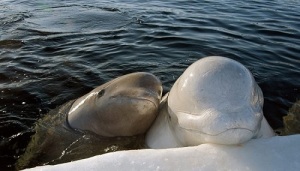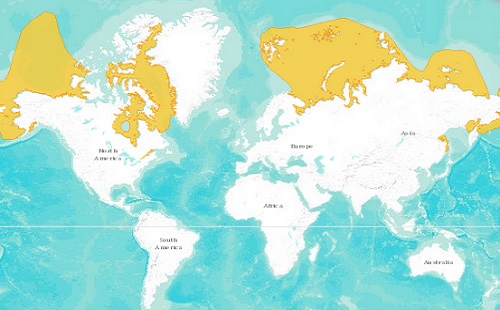Taxonomy

Female beluga with her calf. Photo source: The Telegraph
- Kingdon: Animalia
- Phylum: Chordata
- Class: Mammalia
- Order: Cetacea
- Family: Monodontidae
- Genus: Delphinapterus
- Species: Delphinapterus leucas
Name
- Common name: White whale, beluga whale. Its name comes from the Russian world “beloye” meaning white.
- Scientific name: Delphinapterus leucas. Delphinapterus means dolphin without a wing – or dorsal fin.
Habitat and Distribution
- Beluga whales are widely distributed across the Arctic Ocean and surrounding seas at around 76˚N to 80˚N.
- Its northernmost range reaches Alaska, northwest Canada, Greenland and northern Russia.
- Its southernmost rage reaches the St. Lawrence River in eastern Canada and Sakhalin Island in the Sea of Okhotsk.
- In the winter they inhabit areas of loose pack ice.
- In the summer belugas can be seen ascending rivers.
- According to the International Whaling Commission there are 29 sub populations of beluga whales.
Beluga whale distribution map. Source: IUCN Red List of Threatened Species
Physical Features
- Males are usually 25% larger than females.
- Beluga whales lack a dorsal fin but instead they have a dorsal ridge which is a raised line on their backs.
- The vertebra in their neck is not fused together which makes it very flexible. They can turn their head almost 90˚ to the sides.
- The flexibility of its lips allows them to show facial expressions.
- Beluga whales have from 30 to 40 non-replaceable conical teeth.
- Its blubber can be up to 15 cm thick and provides insulation from freezing waters. About 50% of their weigh is fat.
- They have a rounded bulging forehead that contains an echolocation organ called melon.
- Their sense of hearing is highly developed.
Echolocation
- The beluga whale is a toothed whale and like dolphins they use echolocation to find prey, communicating and navigating.
- Beluga whales produce clicks with their mouth which pass through the echolocation organ, the melon. The sound bounces back from objects in the form or echoes.
- They can determine the size, shape, distance and structure of an object.
- Through the use of echolocation they find breathing holes in ice packs.
Size and Length
- The length of male beluga whales range from 3.5 to 5.5 meters of 11 to 18 feet.
- The length of female belugas range from 3 to 4.1 meters or 9.8 to 13.5 feet.
- Males weight from 1,100 to 1,600 kg or 2,400 to 3,500 lb.
- Females weight from 700 to 1,200 kg or 1,500 to 2,600 lb.
- They reach adult size when they are 10 years old.
Diet
- The beluga whales are carnivore and their diet depends on geographical location and season.
- Where available they eat arctic cod, capelin, pike, marine worms, squids, crustaceans, arctic char and salmon.
Pods
- Beluga whales gather in groups of about 15 individuals called pods. Groups of pods of several hundreds have been observed.
- Pods are unstable; members tend to move from pod to pod. A pod is led by a dominant male. Stable members of pods are females with their calves.
- Belugas in a pod are cooperative hunters.
Behavior
- Beluga whales are highly social animals who communicate using vocalizations such as whistles, squeals, grunts, clicks and screeches.
- They are a migratory species but not all migrate long distances. Seasonal migratory pattern is determined by the amount of daylight.
- Some populations are resident such as the ones in St Lawrence estuary and Cook Inlet.
- In the fall when the ice floor starts to form migratory populations move to offshore waters in central and south Bering Sea along the west coast of Alaska and the east coast of Russia. In the spring they migrate north when the ice pack starts to melt.
- In the summer they gather in estuaries and molt rubbing their skin against the gravel.
- They are slow swimmers but can dive to depths of up to 700 meters or 2,300 feet. They spend most of their time swimming on the surface.
- When they eat they do not use their teeth to chew but only for holding their prey. They tear it apart and swallow it whole.
- Unlike most cetaceans beluga whales can swim backwards.
Reproduction
- Female beluga whales reach reproductive maturity between 4 to 7 years old, while males between 7 to 9 years old.
- They mate from late February to early April.
- Average gestation period is 1.08 years and they will give birth every 2 to 3 years.
- Scientists are not certain but they may experience delayed implantation by which the fertilized egg does not implant into the uterus until conditions are right.
- Litter size is one.
- Fertility decreases when female white whales are around 25 years old.
Calves
- Calves are born in the spring and summer.
- Calves are born gray cream color, they turn brown or gray before turning white at age 7 for females and 9 for males. Their skin will be white for the rest of their lives.
- When they are born they weight 57 kg.
- They lactate until they are 2 years old.
Life Expectancy
- White whales live from 25 to 30 years in the wild.
Threats
- Different populations are subjected to different threats.
- Belugas have been a vital food source for Inuit people for thousands of years. The harvesting of depleted populations put them at risk. The hunting of beluga whales is allowed for subsistence purposes only.
- Decrease of ice coverage due to global warming opens passages to vessels to the Arctic. Belugas respond negatively to the presence of vessels.
- Habitat degradation, pollution and decrease of prey species.
- Belugas can be trapped by ice and become prey to killer whales and polar bears.
Conservation Status
- The IUCN Red List of Threatened Species lists the beluga whale as a “near threatened” species.
- Its trade is protected by Appendix II of CITES.
- It is also listed in Appendix II of Bonn Convention.
- Certain populations are considered critically endangered or endangered.
Did you know?
- Inuit people have been eating muktuk for thousands of years. Muktuk is the top layer or the beluga whale and it is made up of skin and blubber.
References and further research
Convention of the Conservation of Migratory Species of Wild Animals – Delphinapterus leucas.
IUCN Red List of Threatened Species – Delphinapterus leucas.
Michigan University Museum of Zoology – Delphinapterus leucas beluga.
Georgia Aquarium – Beluga whale
National Oceanic and Atmosphere Administration – Alaska Fisheries Science Center

